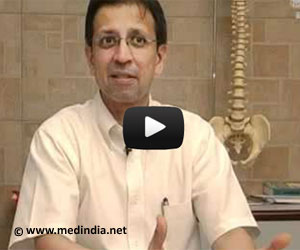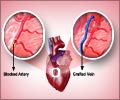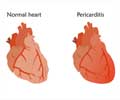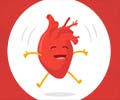Yoga and Heart
Yoga is an alternative system of healing, its power being widely harnessed to prevent and treat various diseases of the heart. Yoga is undoubtedly a reliable avenue for holistic health.
"Health is a state of complete harmony of the body, mind and spirit. When one is free from physical disabilities and mental distractions, the gates of the soul open." - B.K.S. Iyengar
Disease is a manifestation of underlying disharmony in the mind- body domain. Yogic way of life offers a solution to elevate the health of body, mind and soul. Yoga is a cure for many diseases - diabetes, obesity and psychiatric illnesses - as much as it offers immense benefits to alleviate heart diseases.
Yoga has an important role in the prevention of cardiovascular diseases that includes recurrence of heart attacks, hypertension and coronary heart diseases. Yoga influences the hypothalamus directly, the area of the brain that controls endocrine activity, and helps prevent heart attacks.
A complete yoga program involves exercises (asanas), breath control (pranayama), sleep control (yoga Nidra) and mind control(meditation).These are the tenets for cardiac health; also probably the reason why cardiologists universally, recommend yoga to their patients. The curative benefits of yoga enhances heart health, lowers blood pressure, reduces chronic stress, boosts the immune system and enhances cognitive ability.
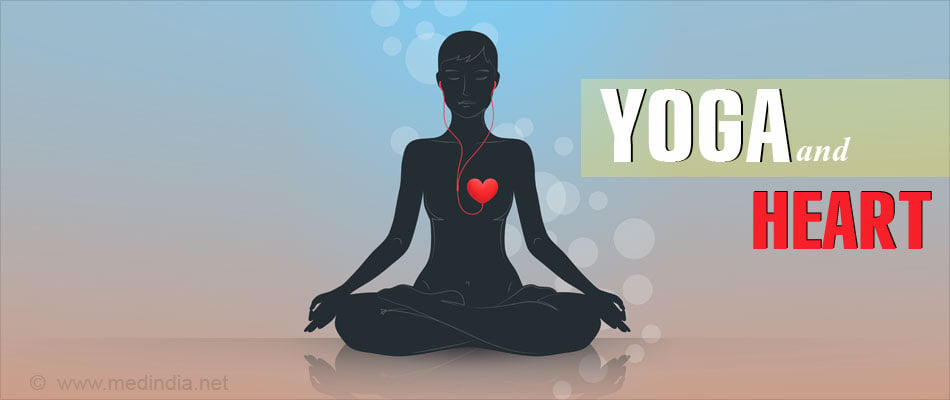
Yoga and its Principle Aspects
Heart disease is a problem of modern times. Improper lifestyle, faulty diet and negative thinking play an important part in triggering heart disease. Our thoughts, feelings and emotions affect our body and mind. Negative emotions spark chemical processes throughout the entire body. Any irritation in the lining of arterial walls - which includes high levels of fat in the blood, smoking and high blood pressure- can trigger heart diseases,
Vedic wisdom in yoga lays emphasis on four aspects that have a direct bearing on health. They are:
Achaar (character and conduct): It stands for moral virtues - truthfulness, chastity, compassion and kindness.
Vichaar (perception or the way we think): The way we think influences our way of life. Develop a positive outlook in life and remove negative thoughts from the mind.
Vyayahaar (the way we behave): It pays to replace undesirable habits with positive ones. If we fear change and cling to old, negative habits, we cannot succeed in yoga.
Ahaar (diet or the food we eat): Food sustains our body. What we eat affects our mind directly. Intake of proper and healthy food nourishes body and mind. Avoid over- eating and eat in moderation.
Any imbalance in any of these aspects results in disharmony of body, mind and soul. This paves the way for diseases.
In addition, mental relaxation through meditation and yoga contribute immensely in offsetting arteriosclerosis (coronary artery blocked due to the deposition of fats on the inner walls of the heart). Thus, owing to its many positive effects- direct and indirect on the cardiovascular system, yoga assumes a pivotal role in heart care.
Yoga - A Whole-Hearted Effort
Yoga is a way to healthy living. Heart is like any other muscle in our body, which works perpetually. Therefore, it needs to be used and then rested.
Recent studies say that diseases of the heart are preventable and reversible. They say that by changing one's lifestyle, one can create a healthier heart. At the deeper level, surgery and drugs do not offer the ultimate solution to diseases of the heart. People with heart disease should not suppress their feelings. Rather they should seek support groups or friends to vent out their emotions. Many people manifest their repressed feelings through the physical body, as disease.
Cardiologists say that, a low- fat diet, preferably vegetarian foods, moderate exercise, a positive frame of mind with the practice of yoga, will help in the cure of the disease. The path of yoga helps in the prevention of stress in healthy people, aids in the recovery of diseases and other illnesses, gives strength to the physical body and helps in weight loss. Yoga induces deep relaxation, and wellness of body, mind and soul.
The five essential parts of yoga practice involve:
- Yoga postures or asanas
- Yoganidra or deep relaxation
- Visualization or imagery
- Meditation
- Pranayama or breathing exercises
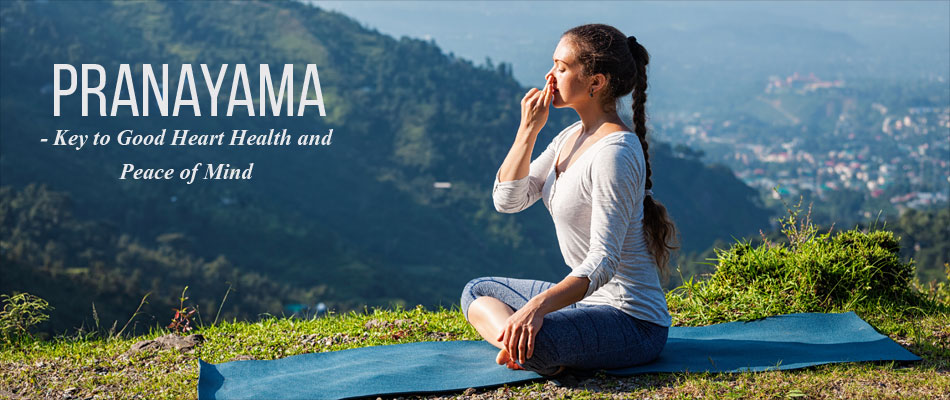
Yoga Postures Or Asanas
Yoga sutras say that a posture that is comfortable and stable is an asana. Stability and feeling of well-being are the results of asana. The practice of asana teaches us to sit erect, keep ourselves healthy and free the mind of thoughts.
The health of the human body depends on the health of the tissues. The organs of the human body are made up of tissues. Practice of asana replenishes the tissues with a fresh supply of oxygen. Elements necessary for nourishment of tissues are carried to them by blood. The circulatory system plays a vital role in the nourishment of tissues.
The heart is the strongest muscle in the body. It can be made healthier by means of proper yogic exercises. It is the contraction and relaxation of the heart that causes circulation of blood to all parts of the body.
Yogic exercises give a good massage to the hard working heart. Asanas involve very little muscular activity. In such a condition, the heart has a tendency to slow down its speed and the heart beats in a controlled manner. When the muscular activity is less, there is minimum production of carbon dioxide. This reduces the levels of stress to the heart.
Asanas improve cardiovascular efficiency even in a diseased person. Asanas are an essential component of yoga that brings steadiness and stability to the body.
Guidelines For Asana Practice
In asana practice, one can afford to stretch the muscles, provided relaxation is practised during the effort. This relaxation helps in enhancing the function and efficiency of internal organs and regulates blood supply to these organs.
A few thoughts to bear in mind...
- Yoga exercises are not about accomplishment.
- Yoga helps in turning inward, focusing the mind and relaxing into the asana.
- Always have a non- striving attitude without the desire to perform the asana in a perfect manner.
- Do not force the stretch and always accept your flexibility. Never try to emulate another person.
- Go easy, Go slowly. Pain should never be a part of yoga.
Yogic Way to a Healthy Heart - Asanas
Anjali Mudra
The word 'Anjali' means to adorn, honor, to celebrate or anoint. This mudra or gesture is also known as Hrdayanjali Mudra, which means, reverence to the self or the heart. This mudra is an excellent way to induce a peaceful state of mind. This mudra is a gesture of reverence to the divinity within.
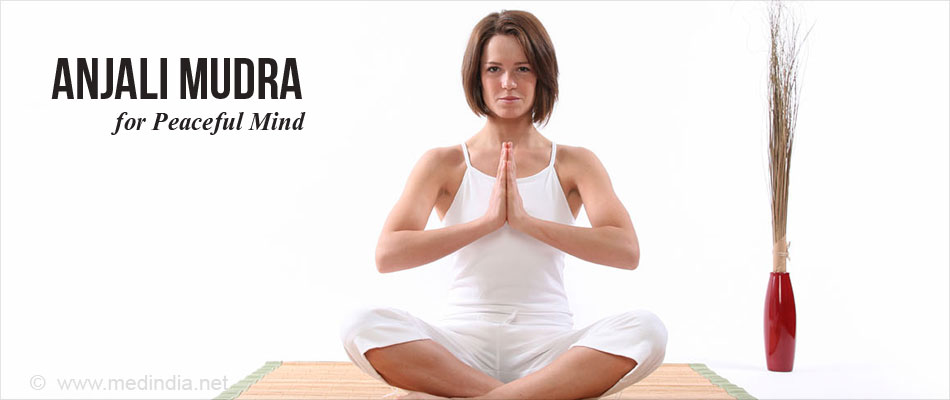
Benefits:
- Balances our energies; the heart is opened to prayer.
- Calms the brain and reduces the level of stress and anxiety.
- Improves flexibility in the hands and enhances poise.
Steps:
- Sit comfortably in a cross-legged position. Inhale and bring your hands together.
- The two hands are pressed against each other and held close to the heart.
- The head should be gently bowed as in prayer.
- Do these mudras for 5 minutes till a feeling of peace takes over.
Swastikasana
In ancient times, swastika was considered an auspicious symbol of good luck.
Benefits:
- Concentration is improved.
- Abdominal muscles are toned.
- Strain on the heart is reduced.
- Functioning of the backbone is improved.
Steps:
- Sit in a cross-legged position with the spine erect.
- Place the right heel on the inner side of the left thigh.
- Then take the left heel and place it on the inner side of the right thigh
- Place your hands on the respective knees.
- Keep the spine erect and close your eyes and free your mind from all wandering thoughts.
- Just be still.
- Sit in this position for 10 minutes.
Bhujangasana (cobra pose)
This posture promotes flexibility in the spine and ensures movement of the chest.
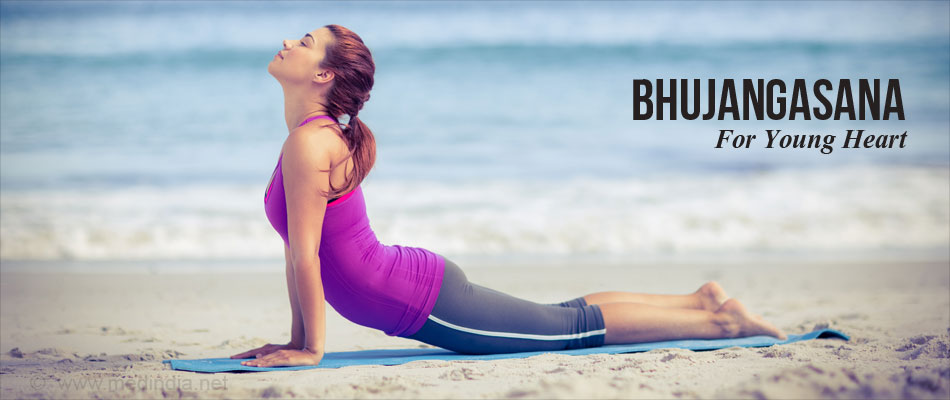
Benefits:
- It strengthens the spine.
- It helps relieve stress and fatigue.
- It opens the heart and lungs.
Steps:
- Lie on your abdomen and place your forehead on the floor. The arms must be placed at the sides.
- Take in 3-4 deep breaths and slowly lift your head away from the floor.
- Then raise shoulders slowly and maintain this position.
- Place your hands besides your chest with palms touching the floor.
- Without raising your stomach off the floor, raise your chest with the arms to balance the body.
- Breathe even and hold this position for some deep breaths.
- Exhale. Slowly lower the body and place your forehead on the floor.
- Repeat the asana 3-4 times and relax.
Viparitakarani
This traditional pose gives strength, restores youth and vitality to the body.
Benefits:
- The practice of this asana improves blood circulation.
- The asana promotes health of the thyroid glands.
- It gives maximum rest to the internal organs.
Steps:
- Lie on your back with hands straight by the side of thighs and palms resting on the ground.
- Slowly raise your legs from the floor without bending the knees.
- Raise the legs until they are perpendicular to the floor.
- Bring the legs slightly towards the head, so that the buttocks are also raised.
- Support your buttocks with your hands. Keep your legs straight with elbows placed on the floor.
- Straighten your legs parallel to the elbows, while giving support to the buttocks.
- Come back to the original position, by slowly bringing the legs towards the ground and placing the hands on the ground.
- Then, bring the buttocks to the ground, keeping the legs straight.
- Bring the legs to the ground and relax.
Limitation:
Those suffering from hypertension are advised to avoid this posture.
Sarvangasana (shoulder stand)
Sarvangasana activates the entire body. It helps stimulate the endocrine, nervous and circulatory systems and rejuvenates the whole body.

Benefits:
- Purifies the blood and ensures good circulation.
- Improves digestion.
- Massages the heart.
- Relieves fatigue, sleeplessness, lethargy and mental sluggishness.
Steps:
- Lie on your back.
- After inhaling and exhaling, lift the legs, hips and trunk till they are vertical and over the head.
- Support the trunk and the back with hands bent at the elbows.
- Bring the breastbone to touch the chin.
- Keep your legs straight and breathe evenly.
- Maintain this position for several breaths.
- Keep your legs straight, relaxed and perpendicular to the floor.
- Breathe evenly and hold for several deep breaths.
- Exhale and slowly come to the original position.
Limitation:
Those suffering from hypertension are advised to avoid this posture.
Pranayama For The Heart
Uddiyana Banda
'Uddiyana' involves pulling the abdominal organs above and below the navel. The uplifting of the diaphragm, massages the muscles of the heart, making it a healthier muscle.
Steps:
- Stand erect.
- Spread the legs with the legs bent more at the knees.
- Slowly lean forward. Place hands on the thighs and exhale fully, until all the breath is thrown out.
- The chest must be expanded and the abdomen must be drawn in. The upper portion of the abdomen must be pulled towards the spine.
- Remain in this position and hold it for a few seconds till you can.
- Then slowly relax the abdominal region and stand erect after inhalation.
Nauli
It should be practiced after uddiyan bandha. It should be practiced always on an empty stomach and never after a meal.
Steps:
- Stand erect with legs apart.
- Bend the legs a little at the knees.
- Place your palms on the thighs and touch the chest with your chin.
- Force all the breath from the lungs by inhaling and exhaling deeply.
- Hold breath; the rectus muscle of the abdomen must be pulled and pushed towards the spine.
- Maintain this position for a few seconds and then relax.
- Begin to inhale evenly.
Yoganidra Or Deep Relaxation
This is a powerful yoga technique, which helps in achieving deep relaxation and awareness of ones own body through yogic sleep. This is practiced by lying down flat on the back. Close your eyes and exhale the air out completely from the lungs. Mentally chant any mantra with perfect calmness. As one does this with tranquility, a spiritual energy is generated and different organs of the body absorb this energy. This energy works on the mind in the sub-conscious level. As a result, all physical and mental disorders get destroyed. Confidence, strong will and concentration increases. Peace of mind follows and enables the practitioner to attain calmness and clarity of mind.
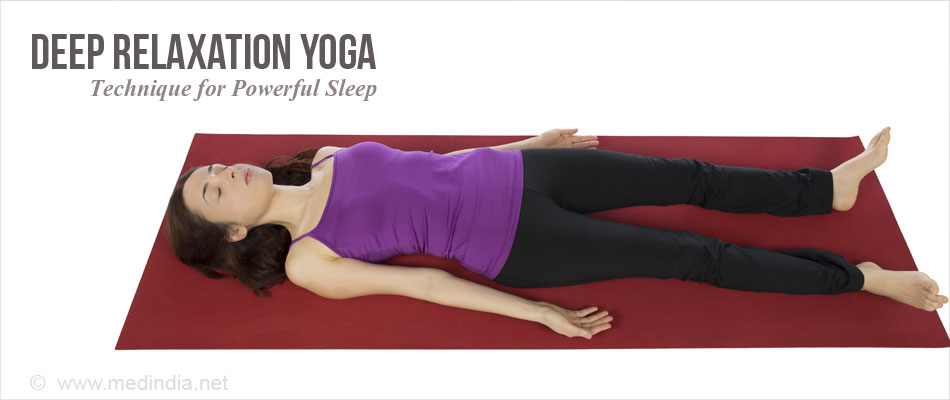
Meditation
Meditation. Sit in a comfortable position. Take a deep breath, hold it briefly and exhale. Gently release any tension that you feel within. Again take a second deep breath, hold it briefly and slowly exhale. Let go of all the thoughts that make you restless. Take a third deep breath and slowly exhale. Release all the energies and distractions from the body and move into a peaceful, serene and tranquil state of mind. Turn your attention to the heart and feel positive vibrations of love, compassion, forgiveness, and understanding emanating from the heart. That will fill you with a feeling of well-being and calmness.






